#station of Liège
Explore tagged Tumblr posts
Text










central station // liège
architect: santiago calatrava
completion: 2009
colorful roof design: daniel buren "comme tombées du ciel, les couleurs in situ et en mouvement" 2022
the place to arrive and depart from in liège is definitely the new central station. it was designed by the famous architect santiago calatrava and the building is definitely a masterpiece. at the time of taking the photos, the roof was still covered with the vinyl foils of the artwork 'comme tombées du ciel, les couleurs in situ et en mouvement' by daniel buren. unfortunately, the installation only lasted until the summer of this year. sadly, the installation only lasted until the summer of this year, so I can't say whether they've been removed, but in my opinion, they could have stayed, and I think many residents feel the same.
der ort des ankommens und des abschieds in liège ist definitiv der neue hauptbahnhof. der entwurf stammt vom bekannten architekten santiago calatrava und das bauwerk ist definitiv ein meisterwerk. zur zeit der aufnahmen war das dach noch mit den vinylfolien des kunstwerkes "comme tombées du ciel, les couleurs in situ et en mouvement" von daniel buren beklebt. die daraus resultierenden lichtsituationen sind grandios. leider lief die installation nur bis sommer diesen jahres und ich kann nicht sagen, ob sie schon entfernt wurden. von mir aus hätten sie aber bleiben können, und ich denke viele einwohner und besucher sehen es ebenso.
#liège#belgium#central station liège#santiago calatrava#design#modern architecture#photography#architecture#architecture photography#gare de liège-guillemins#sncb#urban#urban photography
91 notes
·
View notes
Text

#IFTTT#Flickr#gareguillemins#luik#3d#liège#anaglyph#stereo#redcyan#d7000#dslr#sigma#1020mm#chacha#station#belgium#trein#train#perron#platform#gareguilleminsliège
6 notes
·
View notes
Text

Liége, June 2024
2 notes
·
View notes
Text
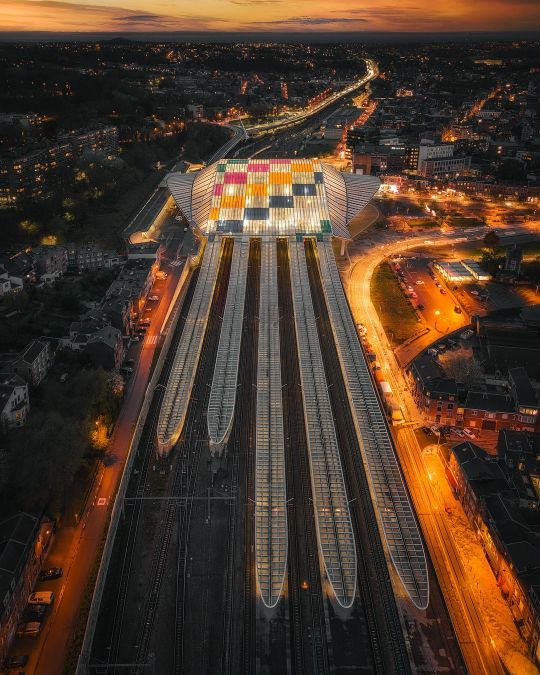
Gare des Guillemins à Liège vue d'en haut
Photographie de Geoffrey LJE
3 notes
·
View notes
Photo

Liège - Part 1
After the exams of the first semester, I visited Liège with my best friend for two days.
Our hotel was near the Liège-Saint-Lambert train station, so we had to take our connecting train here in the Liège-Guillemins train station.
The weather was incredibly well, with a bright blue sky. The sun was so bright, she created these fun light games through the pigmented roof of the Liège-Guillemins train station.
2 notes
·
View notes
Text

Changing trains in Liège, Belgium
0 notes
Photo

Liège-Guillemins railway station in Liege, Belgium.
0 notes
Video
…thesecret… by *ines_maria
#concept#europe#geometry#concrete#belgium#travel#liège-guillemins#secret#monochrome#blackandwhite#future#indoors#calatrava#belgien#architecture#light#station#man#transport#liege#silhouette#WPD22Objects#flickr
0 notes
Photo


Liège-Guillemins railway station / May 2023
95 notes
·
View notes
Text



liège train station, architecture by santiago calatrava
#apparently the coloured overlays are an impermanent art installation but they have such a cool effect with the light#and as a stained glass person i am all for it#my photography#robin talks
7 notes
·
View notes
Text
More of these lets goooooooo!
I like to think that they work within a station within the dreamscape, just floating there like the observatory from super mario galaxy. It would function just like a station. This allows those who live in the dreamscape to travel across it but also makes it easy to to move dreams across the starry void so they can reach their assigned destination and dreamer.
I can try my best to describe it, its much like grand central station in New York with some aspects of Liège-Guillemins Railway Station, Toledo Metro Station and maybe a few others. Eventually ill need to try and draw it but I'm not all that good with buildings. Now a nice aspect is that there a large windows with these light blue curtains the view out into the dreamscape and an ivory colored marble floor. There really isn't ceiling lights but there are these floating star like lamps, that will float around the station, what I can say is that there are thousands of them, but also some dreamscape pokemon do roam around the station even some reagular pokemon that exist there too.
Some of these pokemon include but are not limited too:
Munna Musharna Drowsee Hypno Cleffa Clefairy Clefable A dreamscape form of Absol A dreamscape form of Litwik and its evos Now about how they are chosen, I ruled it out as a family thing or you must study for it, now Emmet and Ingo aren't the only ones with the job in the au there are other stations. Yes Gear Station is STILL Gear Station in this AU but there are a few others.
-Axel Station -Turnpike Station -Mist Station -[Error] <Avoid at all costs> ... the overtaken station...
But enough about that, the twins received the job from their parents, who are still alive. Since their parents retired to take on a lighter less stressful job, the twins where given the job to protect the dreamscape and dreamers. Now it is possible to leave/lose the job, one of them being to retire.
Now other then retiring it is also possible to be fired, yes there are higher ups and no they dont get blasted into the dreamscape space void like my favorite horror game. Nope they are just fired if they dont do the job well, and if the replacements are any better they will get new new replacements and if they are lucky the orignals can be hired back. Sounds confusing but it is super simple. Well thats all I could yap about tonight so until next time!.
5 notes
·
View notes
Photo

Dacht je alles gezien te hebben, dan toveren ze dit uit de grote toverhoed. Combinatie van oud en nieuw: M7 motorrijtuigen omsluiten telkens 3 M4 rijtuigen. We zien deze D'ieteren te Kortenberg als P-trein 8400 naar Liège-Guillemins passeren. @nmbs.be @sncb.be @see_my_kortenberg @alstom @bombardier_jets @dieterencenters #mynmbsstory #nmbs #sncb #belgianrail #igbelgium #thisbelgium #belgië #belgique #belgium #vlaamsbrabant #brabantflamand #flemishbrabant #kortenberg #erpskwerps #dieteren #transport #treinen #trains #station #gare #spoorwegen #sporen #rails #railroads #alstom #bombardier #m7 #m4
6 notes
·
View notes
Text
Trains in Miraculous Ladybug - Bonus: The Bus
[Part 1: The Metro Train]
[Part 2: The Metro Station]
[Part 3: Startrain]
[Part 4: The Gare du Nord]
It’s been a while since I made these posts, but I figured I might as well update them, and talk about the remaining public transit vehicle in the show that hadn’t been mentioned yet: The bus, shown here almost in its natural habitat.

Just like most other vehicles, the show has just the one, which is always signed as line 33 to Gare d'Austerlitz. The line is strictly fictional, just like the Metro lines, to justify this bus appearing everywhere in the city.
So let's talk about the bus itself. In the show, it gets thrown around, used to escape Zombies, it loses its breaks at the start of Gladiator, it's an animal prison, it receives the least destructive cataclysm of all time (in Animan) and way more. While it has no logos, and a slightly distorted front end presumably to avoid copyright infringement (yes, vehicle design is covered by copyright), it is unmistakably an Agora by… well, that's difficult actually, because this bus type has a complicated history.
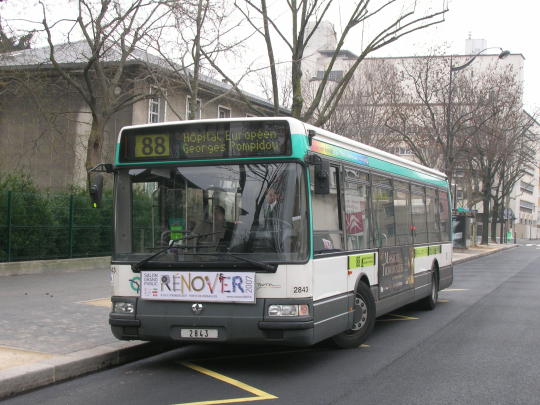

First picture by Vincent Babilotte, from Wikimedia Commons, CC-BY-SA; second by Eole99, from Wikimedia Commons, CC-BY-SA
The Renault Agora was introduced in 1996 as Renault's first fully low-floor bus. In 1999, Renault Véhicules Industriels (commercial vehicles) merged their bus business with Iveco, functionally the commercial vehicle division of Fiat if you squint a bit. The new joint venture was known as Irisbus, and from 2002, the Agora became known as Irisbus Agora. Their logo is actually a dolphin ouroboros if you look closely; I have no idea why.
At the same time Renault and Irisbus were also busy buying companies in eastern europe, and reused their names, which means the Agora was also sold under such famous names (famous among bus nerds anyway) as Karosa and Ikarus in Eastern Europe. Those seem to have been co-branding things, those buses still had either the Renault Rhombus or the Irisbus dolphin on the front, and then a Karosa or Ikarus logo somewhere on the side. Some buses were also sold as Škoda (the part that makes trains, not the part that makes cars). We'll get to those later. Finally, in some countries, it was sold under the incredibly vague name "Citybus".
For Paris, we'll only care about the Renault and Irisbus versions, though. These are functionally the same, they just differ in the logo on the front, which the Miraculous bus simply omits entirely. On the inside, the Irisbus version has newer Iveco engines instead of Renault ones to meet newer emission standards, but that's irrelevant from the outside.
The main feature to recognise this bus from a distance is actually in the rear.

In order to provide a flat floor from the front right to the last seating row, Renault has arranged the engine and related mechanical parts in a sort of backpack. An angled drive shaft drives the rear wheels, which are arranged as a portal axle (a design where there is a small gear set near each wheel so the axle in the middl can be higher or, in this case, lower than the wheel hubs). This design as such isn't unique to Renault; it is also found on some Scania OmniCity buses and several ones in the US, starting with the high-floor GMC Rapid Transit Series in the late 70s. What is unique about the Renault design is how it's packaged, with a gentle curve at the top.

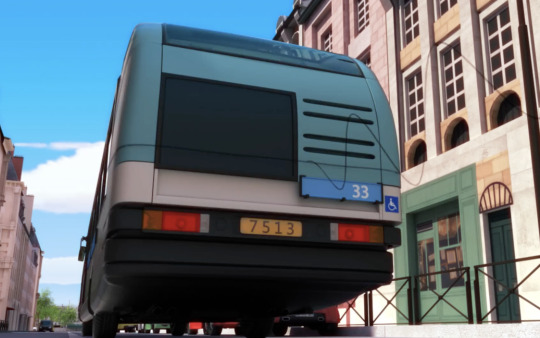
This design actually originated with the Renault R312, the Agora's predecessor, which was semi-high-floor (a single step to get into the bus), and continued to be used by the Agora's successor, the Irisbus Citelis, starting 2006. Here's the rear of one in Liège, Belgium:
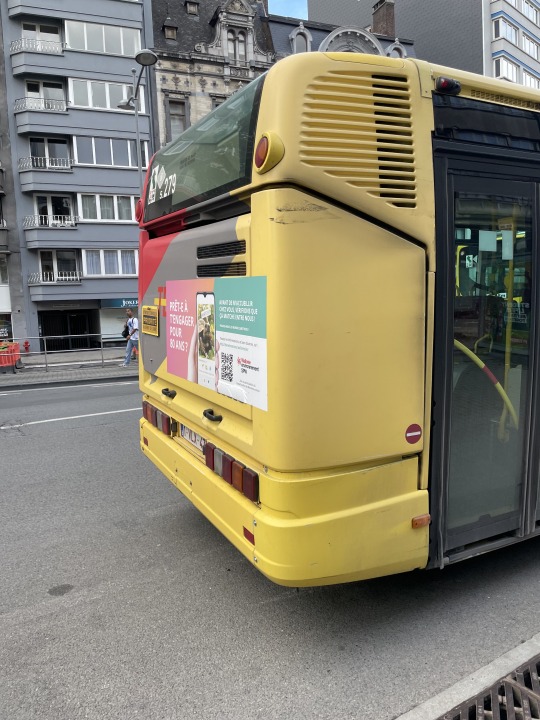
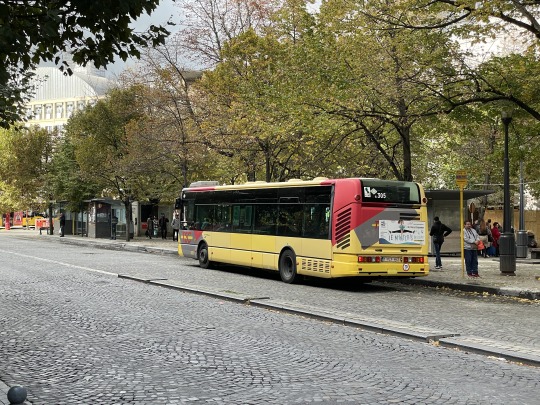
Pictures by me, do what you want with them
In real life, the curve is not quite as pronounced as it is in the show, and the show has given the bus's rear end a pronounced overbite. Again, I think that's due to copyright, but that's just a guess.
The buses also come with a variety of rear lights; the ones on these Belgian buses don't match any of the Agoras or Citelises I've seen in Paris. Either way, the same backpack, now with LED lights, is also used on the Citelis's successor, the Iveco Urbanway.
(Oh yes, in 2013, Iveco bought the remaining share of Irisbus and renamed the bus models to Iveco only, but it's still the same fundamental bus design somewhere in there. The rest of the commercial vehicle division of Renault was sold to Volvo around the time but keeps its name. Note, that's the Volvo that makes trucks, not the Volvo that builds cars, which is completely independent and owned by Geely. This confusing shit keeps happening and it keeps getting worse.)
For extra confusion, there's also a version of all three buses that doesn't have this backpack, and instead has the engine under a raised floor. I'm going to ignore this one here.
I really love all the little details they implemented on the bus, like the colored signs on the outside that show route information.
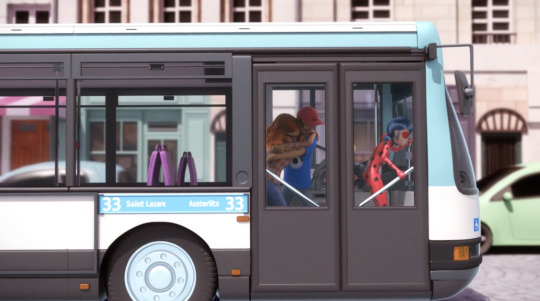
I have no idea why Paris uses these, the buses have digital displays as well, but I like them as a concept.
You can also see the frame for the advertising. In this case it's empty; in other episodes it has shown ads for Adrien, Le Perfume, or for the weather girl contest in Stormy Weather.
On the interior, I'll be honest with you, I'm not that knowledgeable about french buses.
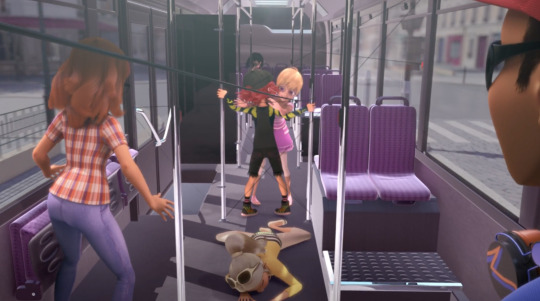
I think the overall layout is correct, but I think the seat color is wrong. Buses and trams owned by Paris's transit operator RATP usually have green seats. Maybe that was another copyright issue? I know that sounds weird, but the transit operator of Berlin (BVG) was recently in a legal battle with the designer of their seat patterns over the question whether BVG could sell merchandise with that pattern. RATP does not have that problem because they sell barely any interesting merch, no matter how much I'd like to buy some.
Next: The dashboard.

We get actually fairly good looks at it in some episodes, in particular Animan, and it looks pretty good.

In partikular, it seems to be a fairly close match for the VDV-Standardfahrerarbeitsplatz, seen here in a Citelis.
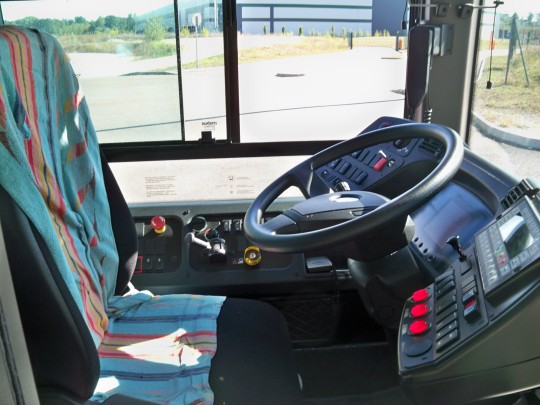
The buttons for the automatic transmissions are in different places here, but both versions seem to be available. Also note that this one has a display unit built in, but it seems that is also optional. The one in Miraculous Ladybug has a separate bus computer unit mounted next to the dashboard, which is a very common layout as well.
As the name implies, the VDV Standardfahrerarbeitsplatz is a german invention by an association of bus operators, who have standardised how a bus dashboard should look like. While bus manufacturers can offer their own, and some do, the standard design is usually also available. The advantage is that if you have buses from three different manufacturers, then you only need to train drivers once instead of separately for each bus. Since german companies build a lot of buses, their standards have become relevant in other countries as well; such as France. Paris has a lot of german-built buses these days as well.
I know the Agora didn't always use the VDV dashboard; you can find pictures of a weird angular Renault design. I don't know if they switched, or if the german standard design became available as an option, and I don't know which version RATP used. But it's certainly a type of real bus dashboard, and one that was used by the same company later on, so I think it's okay.
In some episodes, notably Glaciator 2 and Qilin, we also see the ticketing.

Marinette apparently has a Navigo pass, a contactless card that you touch to the validator in the bus. That seems perfectly accurate. In Qilin, she has forgotten that card, but luckily her mom has bought single-use tickets.

In Paris, you need to validate such pre-bought tickets first, which she does by touching them to the RFID validator.

That's really not how it works in real life. Instead there's a distinct validator for these bus tickets that stamps them, but this bus model doesn't have that. It's okay enough, I guess.
The main issue with the interior of the bus is something else: It has a step.

That's a bit of a problem. In real life, the Agora does not have a step, the entire floor is flat. That was its main advantage over the older Renault R312, which did have the step. I have no idea why the show chose to include a step in here. They're consistent about it as well; there's a step at the rear door, too.
(By the way, do not think about where the doors go when they're open. It's different every episode. They're supposed to swing inwards, but sometimes they swing out, or they just disappear.)
My final nitpick would probably be the underside.
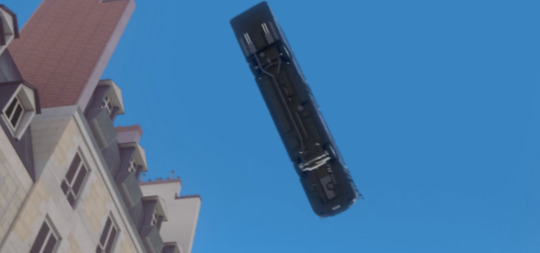
I have no idea what an Agora is supposed to look like from underneath. But given that the engine is in the back, it's probably not supposed to have exhaust lines running all the way under it. Yes, that's as minor a nitpick as they come, but I couldn't resist once I saw it.
Overall, though, it's a good bus, and very appropriate if you only have the money to model one. The Agora is definitely a staple of Parisian cityscapes, with more than 2500 delivered to RATP, almost a quarter of the entire production run.
If there's one issue with its inclusion in the show, it's the age. The last Agora was built in 2006, and most of them have long been retired. A number of them are already in RATP's vast historic collection, which is sadly not open to the public except on special occasions. I don't get why; there would definitely be interest, just look at the London transport museum. Paris's public transport is every bit as iconic as London's, but they don't market it as such, and they don't have the museums and merchandise to capitalise on it, and I think that's just sad. Please allow me to give you money, RATP!
Anyway, these days, no Agora can go into Paris anymore. Paris has established a low emission zone in 2017, and all Agoras are too old to be allowed in. There are some Agoras still running in the wider Paris region, but not the city centre proper (though that one still has some Citelises, and also some Heuliez versions, which is a whole other can of worms). If we assume that Miraculous Ladybug takes place in some sort of eternal 2014/2015, which is still the best guess for a timeline that I've seen, then the Agora still fits, but it would hardly be the only or most common bus anymore.
The age becomes an issue in one particular episode, in Bakerix, where Bakerix complains that the bus is electric, and that's not how it's supposed to be.
In real life, the Agora was never available as a battery electric bus. Paris is buying lots of battery electric buses these days, including ones that have some lineage to the Agora, but the original only ever had internal combustion engines…
…well, except for sometimes. There were also Trolleybus versions of the Agora. First, there is the Škoda 24Tr (normal version) or 25Tr (articulated version), which was confusingly built in two versions, one based on the Agora and one based on the Citelis. There is also an Irisbus Agora Trolleybus with electrical equipment by Škoda. Is that a different trolley bus based on the Agora built in cooperation between Škoda and Irisbus, or is it the same one, and they just sometimes branded it as a Škoda and sometimes as an Irisbus depending on local contracts? Your guess is as good as mine. Either way, though, those were only sold in Eastern Europe. Paris doesn't have any trolley bus wires, so there were no electric Agoras here, ever.
That aside, though, I think Miraculous Ladybug did overall really well on the bus, given the constraints they had to work with, and I'm looking forward to seeing it in plenty more episodes.
I think that's the end of this series, unless the show starts bringing the tram or the RER into it. I don't think they will, because I don't think they could tell any new stories that way, but I would greatly appreciate it. Anyway, thanks for reading!
[Part 1: The Metro Train]
[Part 2: The Metro Station]
[Part 3: Startrain]
[Part 4: The Gare du Nord]
#miraculous ladybug#renault agora#irisbus agora#agora#renault#irisbus#bus#public transit#train reviews#bus reviews
64 notes
·
View notes
Text
Emil Schäfer - Part 1
Family Carl Maria Emil Schäfer was born on 17 December 1891. Named after his father, he went by the name Emil. He had two younger sisters. His father was a fabric manufacturer; two things Emil had in common with his flying comrade Werner Voss whose father had the same profession and also was from the city of Krefeld in western Germany. They also went to the same school, not at the same times though as Werner was six years younger.
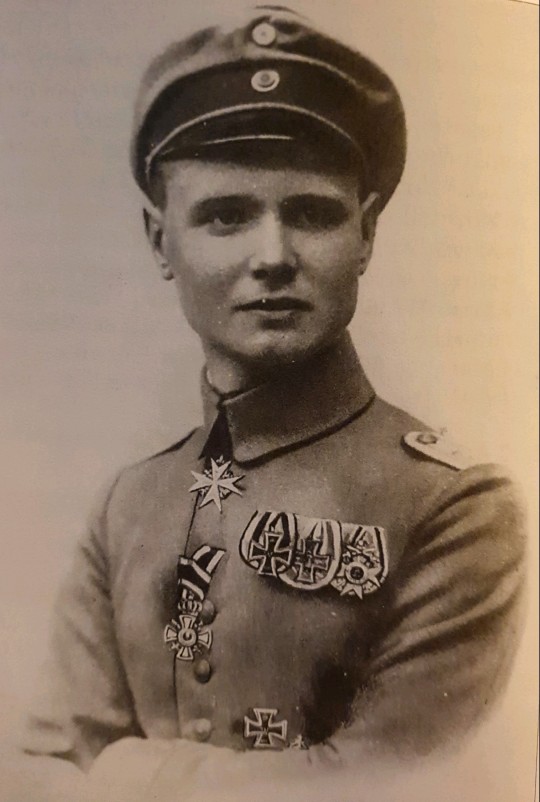
Military service and Work After his graduation in 1911 Schäfer had to do compulsory military service but was able to join the Einjährigen-Programm, so he only had to do it for one year instead of the standart two years. He chose to serve with the Hannoversches Jäger-Battailon Nr. 10 (Infantry) in Goslar. After that, Schäfer was destined to join his father's company and become a merchant. For that he did internships with some of his father´s business colleagues. He had the opportunity to go to London and then to Paris, making him fluent in English and French. Originally he had planned to stay in France for some years, but the year was 1914 so destiny had other plans for him. His father came to Paris to bring him back to Germany, eventhough the imminent threat of war wasn´t yet taken seriously from neither the Schäfers nor their French colleagues: “We joked about our departure, drank to seeing each other again soon, and separated as the best of friends”.

War time service 1914 - 1915 Schäfer, in the rank of Oberjäger, tried to rejoin his old regiment, but was ordered to Westfälisches Jägerbataillon Nr. 7. His first mission was the occupation of Liège, Belgium after its capture the days before. His task was to secure the train station and the bridges around the city. But Schäfer was eager for a more active role in the war: “Hopefully we'll get to the enemy soon. I don't like the police service anymore”. His wish soon came true, and on September 1st his unit is deployed for the storming of Maubeuge. After several days of shelling the fort, they managed to take it. 52,000 men on the French side were captured by 18,000 German troops. After that they were supposed to march on Paris but another unit needed help and after a march of almost 100 km in two days they managed to prevent an enemy breakthrough of the lines.
On September 26, 1914, the course of the war changed for Emil Schäfer when he was shot in the leg while taking the town of Chivry. He had to spend almost 7 months in hospitals and in rehab before he could walk again. The result of the injury was a shortened left leg, which made it difficult for him to walk long distances. He returned to his unit in April 1915 which was still in the same area where he last left them; the city taken and the soldiers deep in the trenches. There he stayed until the end of 1915. He had started to get bored and was also struggling with his injury; his leg was healed, but he found it difficult to walk and stand for long periods of time.
Pilot In January 1916 Schäfer started his pilot training in Köslin. After successful graduation he was sent to Russia in July to join Staffel 8 of Kampfgeschwader 2. His main task was to attack Russian positions with bombs and machine gun fire. “We start twice or three times a day. Occasionally tethered balloons are charred and Russian planes shot down.”

Emil wrote extensively to his parents, describing a day in the life of a pilot: “At 4:45 in the morning my orderly appears and throws me out of bed, half an hour later I appear in my oldest and dirtiest outfit in the dining car, where the gentlemen from squadron 8 and 9 gradually arrive. Coffee, milk, sugar, bread and occasionally a little butter is delivered. Almost everyone still has a pot of jelly, jam, butter or sausage. This first breakfast is very hearty and plentiful, because if you are unlucky, it must be enough for the whole day. Then we go to the airport. When we arrive, the planes are ready. I walk around my good old machine, checking a turnbuckle here and there, then I get attracted. Schubert helps me into my flight pants, buttons, buckles, zips up the various fasteners, has crash aids, goggles and gloves ready. The squadron leader gathers the six crews around him and issues the order. My observer and I now go back to our plane. The plane is started, we take off. Six minutes after the start we are almost 1000 meters high. We're over the city on time, I'm heading straight for the train station and the bombs are already falling. 600 kilograms of the most powerful explosive ammunition poured over the buildings and facilities. Then we go home. The square is lively now. The fitters take over the machines. The observers gather with the squadron leader and report; the pilots still have work to do on the machines, are talking to the fitters, the foreman, and to each other. When everything is done, it's off to the cars and home to the residential train, where everything is discussed again in detail over the second, also very thorough, breakfast.”
In January 1917 Kampfgeschwader 2 was sent to the Western Front. Schäfer was now part of a Jagdstaffel (fighter squadron), flying single seater fighter planes. His first victory almost cost him his life, having to crash land after shooting down a French flyer. Now that he had a taste for being a real fighter pilot, he turned to a former comrade he met in Russia: Manfred von Richthofen, who had recently taken over the leadership of his own Jadgstaffel. In mid-February, Schäfer got the okay to switch to Jasta 11.
10 notes
·
View notes
Photo

Liège - part 10
End of our two-day trip to Liège. We had so much fun, and just having a change of scenery was a welcome thing after nearly three weeks of exams.
We were also lucky to have such beautiful weather. In a country like Belgium where it can both rain, snow and be sunny, having a trip where the sun was shining was so refreshing and nice.
0 notes
Text
VIVA PORTUGAL!
C'est parti !!!
Longue est la route pour rejoindre notre destination : Carvoeiro en Algarve.
Plusieurs itinéraires s'offrent à nous, nous choisissons celui qui passe par le pays Basque. Cela tombe bien, nous adorons cette région et plus particulièrement Saint Jean de Luz.
Partis depuis poltron minet, nous prenons possession de notre chambre à Ascain, en milieu d'après-midi. Nous profitons de l'accalmie météo pour rejoindre Saint Jean de Luz où nous organisons un pique nique apéritif face à la baie et au magnifique coucher du soleil.
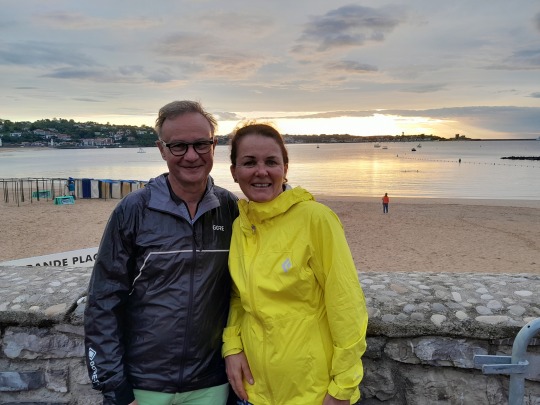
En rentrant à l'hôtel, nous croisons ce panneau improbable qui nous fait immédiatement penser à notre fils!

Nous passons la frontière à 6h30 en direction de Caceres, en Espagne, notre seconde étape.
Après l'autoroute très sinueuse du pays Basque espagnol, se succèdent de très longues plaines agricoles bien grillées. Déconcentrés par ces paysages désertiques, nous en avons oublié de regarder notre niveau d'essence...dommage!, car après une première partie de route constellée de station service tous les 10 km, celles-ci se font beaucoup plus rares! Fidèles à notre réputation, nous sommes cependant sauvés par l'ami "Repsol" (=Total espagnol).
Nous arrivons à Caceres en milieu d'après-midi sous une pluie battante. Tant pis pour la piscine! L'hôtel Extramadura, chiné sur Booking, est un peu comme la ville, d'une architecture rétro des années 70. Armés d'un parapluie, nous partons à la conquête de la partie ancienne de la ville. Après un pique-nique dans notre chambre, nous y retournons le soir : objectif, déguster une sangria! Les monuments anciens sont très joliment mis en valeur par un éclairage. La musique d'un bar branché nous invite à passer le pas de porte. La sangria "maison" est plutôt bien chargée en alcool blanc, Gin?!

Le copieux petit déjeuner nous permet également de prévoir notre pique-nique du midi.
A 10h55, (9h55 locales), nous passons la frontière portugaise, où des cigognes, nichées sur des pilônes, nous accueillent. Les plaines désertiques font place à des champs vallonnés et verdoyants de chênes liège.
Nous faisons une halte à Evora, qui mérite mieux que le court moment que nous lui avons consacré. Capitale de l'Alenjero, c'est une belle petite ville qui comporte entre autre de nombreux vestiges de l'antiquité.

Nous arrivons enfin à Carvoeiro ! Nous donnons rendez-vous à Jean-Michel, notre contact français local. Notre petite maison sur 3 étages, est située dans un quartier résidentiel dans la partie haute de la ville. C'est une maison mitoyenne avec de petites cheminées qui nous a immédiatement fait penser aux "Trullis" vus dans les Pouilles, en Italie.

Ici, toutes les maisons sont blanches, avec des jardins exotiques. Nous pouvons aussi profiter d'une piscine partagée.


Comme il faut remplir le réfrigérateur, nous prenons la destination des 3 mousquetaires. Eh oui, la France est là aussi ! En sortant du supermarché, il fait nuit, le GPS ne connait pas notre rue et le téléphone affiche aucune connexion internet… Nous mettons un certain temps avant de retrouver, enfin!, (grâce à Olivier) , notre maison dans ce labyrinthe !
Le lendemain, nous avons rendez-vous avec Jean-Michel, qui avait proposé une marche jusqu'à sa (très grande) villa, pour un apéritif destiné à nous présenter la région proche et les usages portugais locaux.
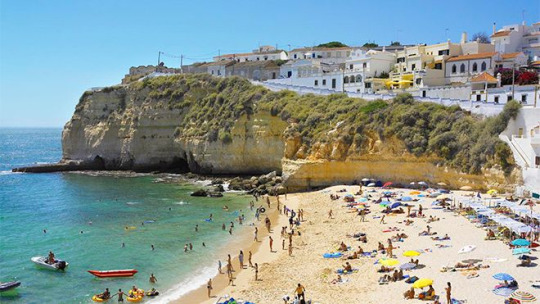
Voici la plage de Carvoeiro.
Les jours suivants, nous visitons les environs et nous constatons que la circulation en voiture est souvent compliquée, parce que les indications de lieux sont aléatoires.
Visite de Portimao, située à quelques kilomètres de Carvoeiro.

Plage de Praia da Rocha
Nous y avons déniché un tout premier restaurant, petit et fréquenté par les locaux, des plats typiques et pas chers.
-------------------------------------
Nous randonnons à Alvor, petit port à 15 km de Carvoeiro. Très belle randonnée sur la plage, longue de plusieurs kilomètres et aménagée de chemins de bois qui permettent la marche à marée haute dans la lagune, sur l'arrière.



6 notes
·
View notes